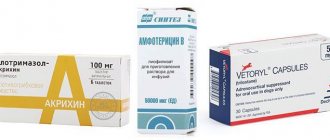Hyperadrenocorticism (Cushing's syndrome) is a rare disease in cats. It develops when there is persistent overproduction of the hormone cortisol by the adrenal glands, or the body receives it orally, topically, or by injection. Excessive cortisol concentrations lead to various abnormalities, including aggressiveness, weakness, and skin changes. Although hyperadrenocorticism is less common in cats than in dogs, it is more difficult to treat, but successful treatment is still possible. Middle-aged and elderly cats are most often affected.
Basic information
This is the name of an extremely rare pathology that occurs when an animal’s adrenal glands produce excessive amounts of cortisol. An excess of this hormone causes complex consequences, among which the most notable are:
- Hair loss.
- Major behavioral changes. In this case, for the time being, the complacent cat may even rush at its owners!
- Severe weakness, apathy.
Important! In cats, this pathology is less common than in dogs, but its consequences are much more severe, and this disease is much less treatable. But this is not a reason to give up without a fight!
Diabetes insipidus in cats
Despite its name, diabetes insipidus has nothing to do with known diabetes, since it has nothing to do with the hormone insulin and sugar metabolism. It is observed very rarely in cats, usually in kittens and young animals.
The antidiuretic hormone of the pituitary gland ADH (vasopressin), which is responsible for maintaining the correct level of fluid in the body, if the normal functioning of the pituitary gland is disrupted, causes diabetes insipidus in cats. Either the pituitary gland does not secrete enough of this hormone (called primary diabetes insipidus) or the kidneys do not respond to the hormone (called nephrogenic diabetes insipidus). A sick animal experiences frequent, profuse urination and equally profuse thirst. Urine has a low specific gravity, transparent, odorless, no protein or sugar (in case of dehydration, urine becomes more concentrated).
Diagnosis If there is no problem with kidney disease and the animal is not dehydrated, tests are performed to further distinguish the etiology of the disease:
- Test – test limiting water consumption.
- Test response to treatment of diuresis with the hormone ADH (vasopressin).
Treatment Frequent urination can be controlled with a medication (desmopressin acetate), which acts similar to the hormone ADH. Treatment is usually lifelong. Water consumption should not be limited.
What causes this syndrome in general?
In general, this question is extremely complex, since in-depth scientific research has been carried out for several years now. Many scientists agree that the main cause is abnormal functioning of the pituitary gland. It is almost impossible to predict when and why it will fail. Even the activity of some parasitic worms, the toxins of which, having penetrated the blood, enter the pituitary gland, can lead to its pathological condition. There is also a possibility of toxic damage due to some types of heavy metal poisoning.
Acromegaly in cats and kittens
Acromegaly in cats is caused by a tumor of the pituitary gland that interferes with the secretion of essential growth hormone. Occurs most often in cats aged 8 to 14 years. The tumor grows slowly and the disease does not manifest itself for a long time. Since this disease is the cause of diabetes mellitus, it is characterized by the usual symptoms:
- Increased thirst.
- Frequent urination.
- Appetite.
In addition, excessive enlargement of the animal’s paws, chin, skull and other parts of the animal’s body is noticeable. The key sign of acromegaly in cats with uncontrolled diabetes is weight gain. The heart, kidneys, liver and endocrine system organs also increase in size. The level of insulin in the blood is significantly increased. Feline acromegaly is suspected in all diabetic cats with severe insulin resistance.
Diagnosis Symptoms, laboratory blood tests, diagnostic tests, computed tomography (CT), magnetic resonance imaging (MRI) of the pituitary gland.
Treatment Radiation therapy has the best chance of successfully treating the tumor. The disadvantages of the method include delayed tumor reduction and duration of treatment (more than 3 years), as well as the development of hypopituitarism, damage to the cranial and optic nerves, as well as radiation damage to the hypothalamus.
The short-term prognosis for the treatment of individual symptoms of acromegaly using various drugs is favorable for cats. However, if the underlying cause of the disease is not treated, the long-term prognosis is poor. Most cats die from congestive heart failure, chronic renal failure, or conditions related to a growing pituitary tumor.
Do we treat or cripple?
No matter how much doctors and veterinarians talk about the dangers of uncontrolled use of hormonal drugs, it is rare that an animal owner listens to them. Everyone considers themselves at least Parcelsians, and therefore easily and naturally follows the advice of “experts” from the Internet. “Treat” a cat with hormonal ointment from the pharmacy? Yes Easy! But you don’t need to be surprised later that your pet has “something wrong” with his health.
As you might have already guessed, problems with the pituitary gland may well be provoked by the uncontrolled use of various “drugs” without a veterinarian’s prescription. The particular danger of hormonal disorders of this class is that they do not develop suddenly and not immediately. Having “treated” your cat’s eyes with hormonal drops a couple of years ago, you will in no way associate Cushing’s disease in cats with this fact. And the veterinarian will only have to be tormented by guesses about what exactly caused the appearance of the disease in this particular case.
Adrenal insufficiency in animals - hypocortisolism
Adrenal cortex insufficiency (HYPOCORTICISM) is characterized by severe disruption of all types of metabolism due to a decrease in the synthesis of glucocorticosteroids, mineralocorticoids and androgens by the adrenal cortex.
There are primary and secondary chronic adrenal insufficiency, while primary hypocortisolism is characterized by destructive processes in the adrenal cortex, and secondary hypocortisolism is caused by a deficiency of ACTH (adrenocorticotropic hormone), which stimulates the adrenal cortex.
Causes of adrenal insufficiency
The causes of primary adrenal insufficiency include those that destroy the tissue of the adrenal cortex: fungal toxins, viral infection, tumors, autoimmune processes. Patients often have autoantibodies to adrenal tissue or to ACTH receptors. Autoantibodies to adrenal tissues are immunoglobulins of the IgM class. Primary adrenal insufficiency can manifest itself as a multimorbid disease, combined with hypoparathyroidism, thyroiditis, and diabetes mellitus. Primary adrenal insufficiency is called Addison's disease. Other causes of hypocortisolism may be amyloidosis, hemochromatosis, effects of radiation therapy, and fungal toxins.
With secondary hypocortisolism, functional insufficiency of the adrenal glands occurs due to dysregulation at the level of the hypothalamic-pituitary system (corticotropic insufficiency). In this case, a secondary decrease in adrenal activity is caused by a deficiency of ACTH produced by the anterior pituitary gland, which is dependent on corticoliberin (corticotropic releasing hormone) secreted by the hypothalamus. Secondary hypocortisolism corresponds to a deficiency in glucocorticoid production with preserved mineralocorticoid production. Primary hypocortisolism differs from secondary hypocortisolism in the dysfunction of mineralocorticoids, which is reflected in the clinical manifestation and treatment methods.
Pathogenesis. In case of the disease, insufficient synthesis of glucocorticoids is noted, and with secondary hypocorticism and mineralocorticoids, protein, carbohydrate, lipid, and mineral metabolism are disrupted. In the body, the process of gluconeogenesis is inhibited, the formation of glucose and glycogen from non-carbohydrate substances is reduced, a hypoglycemic state occurs, and poor supply of tissues with glucose occurs. With insufficient synthesis of glucocorticoids, protein synthesis in the liver is inhibited, and androgen deficiency weakens various anabolic processes. Insufficiency of ACTH secretion leads not only to atrophy of adrenal tissue, but is also accompanied by impaired secretion of gonadotropic, somatotropic, thyroid-stimulating and other pituitary hormones. Therefore, the disease takes on a polymorbid (combined) character. The excretion of sodium in the urine increases, and potassium is retained in the body. Calcium metabolism is disrupted: its absorption in the intestines increases, the release of calcium from bone tissue increases, which leads to hypercalcemia.
Symptoms. Symptoms of hypocortisolism are mild. Apathy is a common sign of the disease, anorexia, and emaciation. Hypothermia. Bradycardia does not appear constantly, but is an important sign of the disease. Muscle weakness (myopathy) and skin hyperpigmentation are noted. Against the background of general hyperpigmentation of the skin, areas of depigmentation - vitiligo - may appear, which indicates an autoimmune process. The pulse is small, soft, slow, blood pressure is low. Hypotension appears as a result of insufficient secretion of cortisol and catecholamines, depletion of the body in sodium, and a decrease in extracellular fluid (dehydration). There are signs of dysfunction of the gastrointestinal tract: nausea, vomiting, anorexia, constipation followed by diarrhea.
Laboratory tests for primary chronic adrenal insufficiency establish a sharp decrease in the blood serum sodium content and an increase in potassium (Na/K ratio below 24), a decrease in cortisol concentration, hypochloremia, hypercalcemia, uremia. The level of creatinine in the blood is increased.
Laboratory diagnosis of secondary adrenal insufficiency is very difficult and problematic in real conditions.
During pathological examination, various changes are found in the adrenal gland or in the cortex: infiltration by lymphocytes, proliferation of fibrous tissue, and in the case of an autoimmune process, atrophy of the cortical layer.
Diagnostic criteria. Muscle weakness (myopathy), decreased nutritional status. Skin hyperpigmentation. Decreased blood pressure.
Laboratory tests for primary adrenal insufficiency in the blood serum (plasma) indicate a decrease in sodium content (below 310 mg/100 ml, below 135 mmol/l), an increase in potassium above 22 mg/100 ml (above 5.6 mmol/l), creatinine above 167 µmol/l, a decrease concentrations of cortisol, aldosterone.
Treatment. The diets are filled with food rich in energy, protein, and vitamins. Table salt is added as an additive. As replacement therapy for a long time (almost for life), synthetic hormonal drugs are prescribed - cortisone acetate, prednisolone, Cortineff, hydrocortisone acetate, etc.
Cortisone acetate (adreson, cortelan) is a drug of the adrenal cortex that has a multifaceted effect. Prescribed orally for Addison's disease, acute adrenal insufficiency in therapeutic daily doses: horses, cattle 0.1-0.2 mg/kg, pigs, sheep, goats 0.3-0.5 mg/kg, dogs 0.5- 1.0 mg/kg. The daily dose is given in 2 doses. Available in tablets of 0.025 g.
Hydrocortisone acetate is a drug for the adrenal cortex. Prescribed orally in approximate doses of 0.5 mg/kg per day. Give the substance in fractions 3 times a day. The dose is selected individually.
Cortineff (fluorohydrocortisone acetate, fludrocotisone, florinef, fludrocortisone acetate) has a strong anti-inflammatory (7 times stronger than hydrocortisone) and mineralotropic effect. Used orally for primary adrenal insufficiency (Addison's disease), secondary adrenal insufficiency, and for damage to the pituitary gland - in combination with cortisone.
Prednisolone (dacortin, metacortalone, nisolone, prenalone) is a glucocorticosteroid with anti-inflammatory, desensitizing, antiallergic effects. Produced in tablets of 0.005 g, in the form of 0.5% ointment, in ampoules. Prescribed orally in approximate initial doses: dogs 0.5 mg/kg, horses, cattle 0.025-0.05 mg/kg, pigs, sheep, goats 0.1-0.2 mg/kg per day.
According to foreign data, fluorocortisone acetate and deoxycorticosterone acetate (Cortexone) are used to treat hypocortisolism in dogs and cats. Fluorocortisone acetate is prescribed orally at the rate of 10-20 mcg/kg for dogs, for cats 100 mcg per day per head. If the use of fluorocortisone acetate is ineffective, it is replaced with deoxycorona acetate, which is prescribed intramuscularly at the rate of 0.1-0.2 mg/kg once a day. Then the administration of the drug is limited to 2-3 injections per week.
Prevention. Animal owners must protect them from stress, avoid hypothermia and overheating, use of poor quality feed, underfeeding and overfeeding. Glucocorticoids are used almost for life: doses are temporarily increased in case of unfavorable factors of feeding and maintenance.
How does it manifest?
In principle, we have already described some symptoms at the very beginning of the article, but now is the time to talk about them in more detail. You should be especially wary if your pet exhibits the following:
- The cat constantly drinks and pees.
- At the same time, the animal exhibits a brutal appetite, but its weight remains the same, although its belly grows. Of course, this can also be attributed to pregnancy, but if you have a cat, it is still unlikely...
- Over time, the cat loses mobility, its muscles become weak and flabby.
- The condition of the coat is constantly deteriorating: it becomes thin and brittle, and the skin loses its elasticity. The last sign is so serious that in some animals, with the slightest mechanical impact, deep abrasions and cracks form.
Please note that the combination of all these symptoms with diabetes is a 100% guarantee of Cushing's syndrome. In the photo, such animals look very bad: severe emaciation, the skin is almost completely covered with deep, non-healing ulcers.
What symptoms can you notice on your own?
It is impossible for the owner to understand that a tumor is forming in the cat’s brain in the early stages. Most neoplasms manifest themselves at a significant volume, when they begin to compress intracerebral structures. Loss of vital functions occurs, but even with obvious clinical symptoms, it is necessary to exclude diseases similar in characteristics to a tumor.
At the very beginning, a cat owner may suspect something is wrong based on the following symptoms:
- the animal does not want to sit in your arms;
- behavior change;
- lack of “music”;
- decreased activity.
Such behavioral reactions are not typical for tumors under the skull. They simply indicate discomfort in the animal’s well-being. The duration of the asymptomatic course is explained by the adaptation of brain tissue to changes in pressure; the cat itself can adapt to some symptoms, and the owner attributes this to the pet’s character traits.
The strength of neurological signs of a brain tumor in cats directly depends on the location and size of the tumor, the degree of compression of surrounding tissues and the formation of metastases.
When the pathological process is started:
- wanders aimlessly around the house, her gaze is frozen, her body is tense, stiff, she often bumps into corners and furniture;
- often begins to move in a circle;
- often makes uncharacteristic, hoarse and hysterical sounds;
- periodic and frequent seizures, fainting, convulsions.
Paraplegia and paralysis are not excluded, although they are more typical for spinal cord tumors. Short-term, partial loss of hearing and vision is common. If the nerves responsible for the perception of the surrounding world are “absorbed” by the neoplasm, the cat will become completely blind.
When the brain is damaged, aggression, disturbances in breathing and swallowing are possible, strange “quirks” and perversion of taste appear.
Diagnostics
Only (!) in a well-equipped veterinary institution. Please note that many of the above signs can only be given by the diabetes mellitus we mentioned, and in fact, its diagnosis requires specific equipment and tools. In any case, you won’t be able to find out anything in your kitchen. Besides, Cushing is an extremely serious thing. The animal's condition quickly deteriorates without the help of specialists; not a minute can be lost!
What types are there
Neoplasms are formed directly from brain tissue or its membranes or penetrate “from the outside” from adjacent structures. A tumor is often a consequence of cancer metastasis from other organs and systems and penetrates through the hematogenous (lymphogenous) route. The reasons for their formation are not known for certain; it is assumed that a combination of factors plays a role in the occurrence of neoplasms. Brain tumors in cats can form due to poor diet, exposure to the external environment (chemistry, ecology, viruses), as a result of injuries, or decreased immunity.
What tumors are diagnosed at the Ros-Vet VC:
- benign, slowly growing, without metastases, easily separated from healthy tissue cells;
- malignant, fast-growing, with extensive metastasis throughout the body, they are difficult to limit and remove;
- intra-axial, located deep in the brain, formed from brain stromal cells;
- extra-axial, extracerebral cancer, the primary focus of pathological cells is found in the pituitary gland, meninges and nerves.
Primary neoplasms are formed directly from brain tissue. Secondary are those that penetrate the brain through metastasis or excessive growth from adjacent structures.
In cats, at the Ros-Vet VC, veterinarians often find tumors: gliomas, meningiomas, papillomas, pituitary macrocarcinoma, etc.
Therapeutic measures
Is there any treatment for Cushing's syndrome in cats? Yes, there are more or less effective schemes. Firstly, the drug Trilostane can be used. It suppresses the production of cortisol. It can only be prescribed (!) by a veterinarian and the drug is used only under his supervision. If you overdo it, the hormone will stop being produced altogether, and this is also very bad.
If, in a veterinary clinic, it is determined that a pituitary tumor is to blame, the doctor may recommend surgery. Of course, this is only advisable in the case of young animals, since the body of an old cat simply cannot withstand such a serious operation. An option is chemotherapy, but this is also prescribed with extreme caution.
In addition, surgery may involve removal of the adrenal glands themselves. In this case, the cat will be on hormone replacement therapy for the rest of its life, but this is still much better than the manifestations of Cushing's syndrome itself. Overall, there are options, so you shouldn't give up!
Panhypopituitarism in cats and cats
In this disease, the pituitary gland and nearby organs, including the hypothalamus, are compressed or damaged, which interferes with the functioning of other hormone-producing glands, resulting in various symptoms and diseases. This may be due to injury or infection. They lead to the destruction of pituitary tissue, which causes hormonal deficiency.
One of the causes of panhypopituitarism may be inactive tumors with a long development period. The tumor can become quite large before the affected cat shows signs of illness. The disease is equally likely to develop in cats of any breed, but older cats are most often affected.
Symptoms : A sick animal's behavior changes, they stop responding to people, look depressed, usually try to hide, coordination is impaired, and weight loss is noted. Despite the fact that they are thirsty and constantly consume liquid, they show signs of dehydration. The cat's urination significantly increases and its urination habits are lost - it begins to “go” to the toilet not only in the litter box. In the chronic form of the disease, the growing tumor of the pituitary gland puts pressure on the optic nerve and the animal goes blind.
Treatment Radiation therapy can shrink pituitary tumors and reduce symptoms of the disease, but experience in treating cats with large pituitary tumors is limited. The forecast leaves much to be desired.











